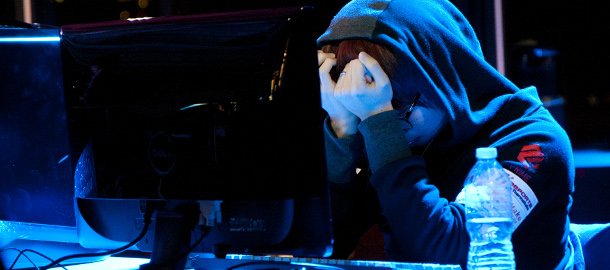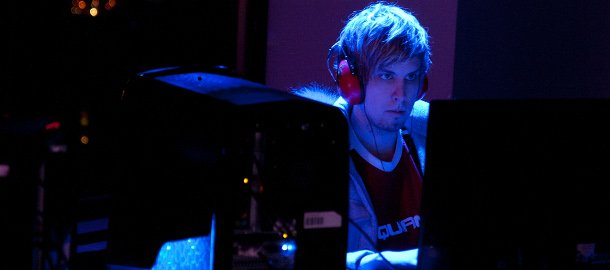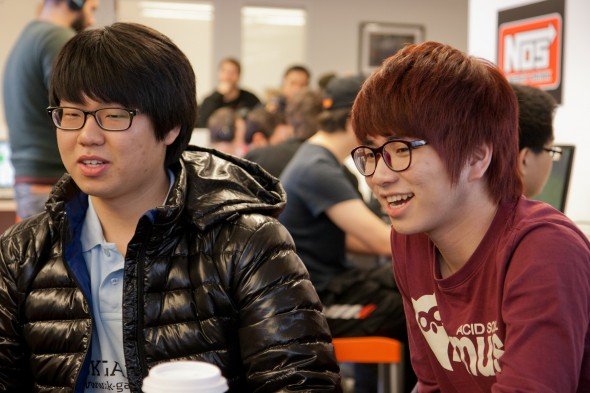
Last weekend, I spent a few hours watching the MLG Winter Arena on the MLG's pay-per-view streams and I have to say, as someone who has always been a bit leery of eSports and does not particularly care for StarCraft 2, it was an incredibly good time. Not just as a StarCraft or gaming experience, but as a sports event. Old news to a lot of competitive gaming fans, but a pleasant surprise for someone just getting into eSports.
Part of that was due to the high quality of the MLG's production and the way it ran the streams. With five streams and about a half-dozen casters, there was almost always something to watch and most of it was pretty good. I ran into the odd bit of lag (some of it very poorly timed), and occasionally the casters lapsed into the same kind of banalities with which fans of any sport are familiar, but those were the exceptions to an otherwise stand-out presentation.
I was particularly grateful for the casting team, especially Artosis and DjWHEAT, who managed to make a fast-paced and complicated game very accessible to a novice like me. I was worried that by going PPV, the production team would simply focus on the hardest of the hardcore. I was relieved that wasn't the case.
I know the move to PPV was a controversial one, and I can easily understand why people might take issue with that. But by Saturday night, I don't imagine there were many viewers who felt they had mis-spent their $20.
The MLG has since announced two more PPV Arena events in the Spring season, and I asked MLG Senior VP of Operations Adam Apicella whether PPV is now the future of the MLG.
"Yes and no. I don't think a 100 percent PPV approach is the answer," Apicella said. "However, I do think a blend of open broadcasts mixed with some high quality PPV activity is something we will look to explore, an approach that resembles the UFC model. Continuing to grow the audience is still a major focus at MLG and with our freemium Championship Events, we hope to do just that. Fans will have the opportunity to watch both free and paid streams of the Winter Championship at the end of March."
NaNiwa's Mobile Maginot Line
The replays won't be available for a few more days, but I have to tell you about a couple amazing moments from the tournament. They don't require any deep appreciation for StarCraft or its strategies, they were self-evidently feats of skill and ingenuity. Maybe when you hear about them, you'll understand why I'm going to be paying a lot more attention to competitive gaming moving forward, and can't wait for the MLG's Winter Championship in Columbus next month. Beware, match spoilers abound .
The biggest gaming news, reviews and hardware deals
Keep up to date with the most important stories and the best deals, as picked by the PC Gamer team.
The first moment that brought me to my feet came during the Leenock - Naniwa match on Saturday night. Leenock (Lee Dong Nyung) is a Korean Zerg player, and he'd put NaNiwa (Johan Lucchesi, from Sweden) on his back-foot in the first game. NaNiwa used what the casters calling the match said was a total cheese tactic: he had a drone go to NaNiwa's natural expansion and start building a Zerg Hatchery, cutting off NaNiwa'a access to the site. Every time Naniwa nearly succeeded in killing off the hatchery with his Protoss probes, Leenock would simply cancel the construction, recover the resources, and move the drone a few spaces over and start building another hatchery. It completely sabotaged NaNiwa's opening, and he had to concede.

The second game got off to a similarly rocky start for the Swedish Protoss player. He got behind early and found himself holding Leenock's Zerg at bay with nothing but a swarm of Stalkers and Sentries. These were cheap, low-tech units, but Naniwa could not stop building them because he could not spare the resource necessary to improve his technology and build better units. Finally, with the game fast approaching a tipping point, Naniwa took his force from the center of the map and started probing Leenock's bases. He sent a force to one of the expansions, and used the Blink ability to warm them onto the plateau so they could start raiding the drones collecting resources. Leenock immediately attacked the raiders, but just as his Zerg got there, NaNiwa used the Sentries to create a wall of Force Fields between his ranged Stalkers and Leenock's army.
But with NaNiwa's force split, and half of it trapped on the plateau, Leenock went in for the kill against the other half. Zerg swept like a wave toward Leenock's army...and broke against another wall of Force Fields that formed an enormous crescent around the Protoss troops. The Stalker raiding force Blinked down into the valley to join battle. The Stalkers were deadly by virtue of their sheer numbers, and the Zerg simply could not get in close enough to do serious damage, especially since the Stalkers were free to target and slaughter all Leenock's ranged units. Every time Leenock tried to launch an attack, NaNiwa created another perfect line of Force Fields, so that it was almost like they were fighting from within a moving breastwork. Leenock conceded the match after breaking his army on those walls.
And at that moment, it was like the spell Leenock had put on Naniwa was broken. The final match was also very good, but NaNiwa was much more aggressive and dominant, knowing that Leenock did not have any answer for his Force Field micromanagement. It's worth seeing the end, where he used Force Fields to prevent Zerg from escaping an attack.
MarineKing Takes a Crown
The other highlight isn't so much a single moment, but a series of them. The finals between Koreans DongRaeGu (Park Soo Ho) and MarineKingPrime (Lee Jung Hoon), Zerg and Terran respectively, were an emotional roller coaster and a perfect clash of opposing styles.
MarineKing came into the game needing to win a two-out-of-three series, since he was the champion from the winner's bracket and DRG was coming from the loser's bracket. He won his first match, then imploded as DRG took two in a row and forced the series into a best of 7. MarineKing looked beaten, and DRG looked as dominant as he ever had throughout the weekend.

Worse still, MarineKing had a history of coming up short in final rounds, and the casters were starting to wonder if this was a mental block. However, MarineKing came back to win three in a row. He fixed his struggling bunker rush, saving one failing assault by having the SCV's stop work on a bunker and heal each other faster than the Zerg could destroy them. It was fast-thinking and even faster micro-management. Marines came up to rescue them, they finished the bunker that cut DRG off from his natural expansion, and DRG conceded. In another match, MarineKing sent a small assault force to storm one of DRG's bases, and flew a factory in behind them to block DRG from sending reinforcements. By the time DRG found a way past the factory, the expansion was gone and so were his hopes of victory.
When MarineKing won the tournament in Game 6, he sat at his computer, looking confused as DRG began packing up. He was intent on his screen, like he was getting ready for another match, when the news got through to him that it was over. He'd finally won a major tournament, and done it by coming from behind to beat one of the strongest Zerg players in the world.
Fromage Party
I was surprised, and so were the casters, at how often players resorted to cheese tactics, and how often those tactics worked. I asked Rod Breslau, one of the hosts of the Live on Three eSports podcast and a freelance eSports reporter (check out his reports from the Winter Arena , for GameSpot) if the use of cheese tactics at the Winter Arena was unusual.
Not really, in his view. "You really have to have 'cheese' in your repertoire. Because if you don't have it, your opponent knows what you are going to do already. If you're not able to surprise your opponent with something that they're not expecting early on in the set, you're probably not going to win."
Breslau explained that people can still win by playing standard strategies, but they still have to be prepared to defend against a number of cheese tactics. If they don't have their own brand of cheese, they end up ceding some of the initiative over to players who do employ cheese tactics. Oddly enough, it's Korean players who tend to employ cheese, while non-Koreans ("foreigners" in the Korea-centric vernacular of Starcraft) tend to play things straight. If there was more cheese than usual at the Winter Arena, Breslau pointed out, it is probably because more foreigners like NaNiwa and Huk are embracing it.
"Every GSL champion ever and nearly every foreign champion ever, has had some cheese in their gameplan that they perform in some of the matches," Breslau said.
It will be interesting to see whether these sorts of tactics play an expanded roll at the MLG Winter Championship in Columbus, OH from March 23 - 25. They played an occasionally decisive role at the Winter Arena, but these tactics are only really effective when, like the Spanish Inquisition, nobody expects them.
All photos courtesy of TeamLiquid.net-Rich

